Thanks David. I always enjoy looking back through my notes and photos in order to put these retrospective reports together. They also start my thoughts turning as to what I would like to see next season.
Cheers Wurzel. I was chuffed with that Marsh Fritillary, particularly as it was the only one I saw this year.
Our daughter Sarah has come up for a couple of days and this morning has gone off Christmas shopping with Jane. I managed to get away with not going as long as I dropped them off so having done that I have managed to get this next look back report finished.
Looking back at 2021 Part 2 - Summer.
As we passed into June and the beginning of meteorological summer there was a bit of an improvement in the weather that began around the Whitsun Bank Holiday. This upturn in the weather lasted for a good couple of weeks, although some days would still see quite a bit of cloud bubble up into the afternoons and there was often a cool wind to keep temperatures down a bit.
The first week of June finally saw
Common Blues and
Small Heath show up at my local sites although numbers of both were low and I failed to find any first brood
Small Coppers or
Brown Argus at all locally.
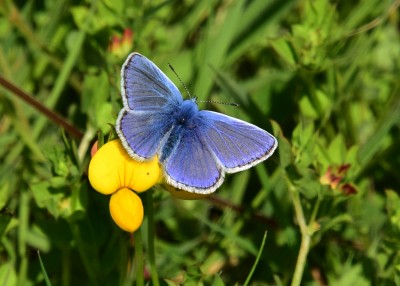
- Common Blue - Blythe Valley 02.06.2021
I did find a single Brown Argus down at Bishops Hill when we went there on 3rd of June to look for Small Blues, of which we found good numbers of fresh examples flying.

- Brown Argus - Bishops Hill 03.06.2021
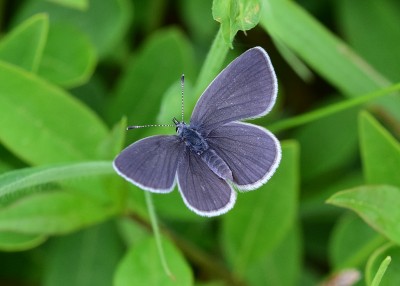
- Small Blue - Bishops Hill 03.06.2021
Bishops Hill also produced my first
Dingy Skippers of the year although numbers were well down on what I would usually expect to see here. I am not sure if this was down to the timing of our visit although we did go later than I normally would. A
single Grizzled Skipper also provided one of only two sightings of this species this year, the second being at Harbury Spoilbank later in the month.
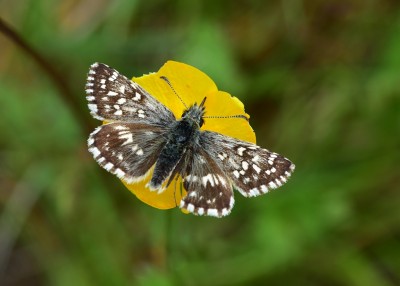
- Grizzled Skipper - Bishops Hill 03.06.2021
In a good (or what had become normal more recently) year I would have expected to have seen all the above species before the end of May but this year they were all definitely late emerging due to the cooler spring. In fact, the first week of June still felt very much like mid spring around here with Orange-tips still flying in reasonable numbers along with good numbers of winter hibernators still hanging around.
On 12th June we set off for Dorset for a family holiday and a stop off at Fontmell/Compton Down produced my first
Adonis Blues and
Painted Lady of the year along with Dingy Skippers, Brown Argus, Common Blues and Small Heaths.
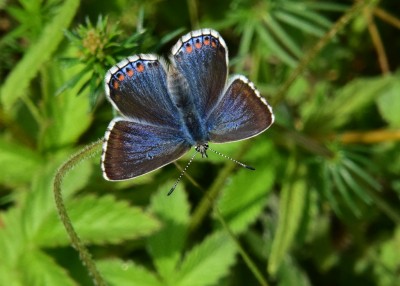
- Adonis Blue female - Compton Down Dorset 11.06.2021
This stop off also rewarded us with a
Glanville Fritillary, a species that has apparently been unofficially released on a number of sites around in the south. I won’t comment here on the ethics of this release other than to say it somehow felt ‘wrong’ to see it here, but on the other hand it was nice to see a species that was not at all on my radar for this year.
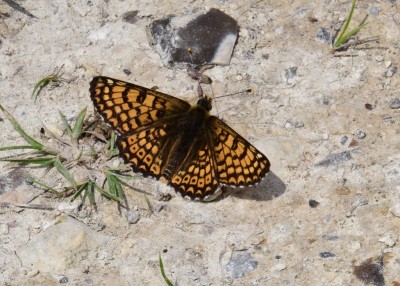
- Glanville Fritillary - Compton Down Dorset 11.06.2021
The following week down in Dorset, during which we stayed in a caravan at Durdle Door, provided lots of Adonis Blues and Dingy Skippers on the grassy slopes above the famous rock arch and along the nearby downs. Lots of these were in good condition still, again indicating how late the season was running. Smaller numbers of Common Blues, Small Blues and Brown Argus were also flying here along with good numbers of
Lulworth Skippers.
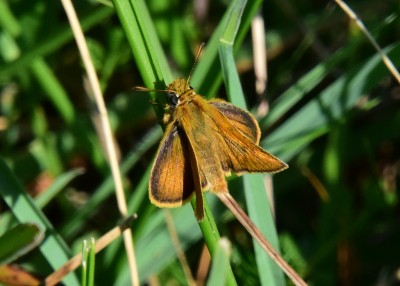
- Lulworth skipper - Durdle Door 15.06.2021
A few, mostly faded
Wall Browns were still flying on these slopes and most days saw a few
Red Admirals and Painted ladies also turn up.
The first
Meadow Browns and
Large Skippers appeared down here (on 12th June) with numbers of both slowly building through the week.
All of these species would also be seen at other sites around the area during the week but Durdle Door definitely had the highest numbers of most species, especially in the first day or two of our stay.
A visit to RSPB Arne on 14th June produced a single fresh male
Silver-studded Blue with lots more of these flying at Higher Hyde Heath a couple days later.
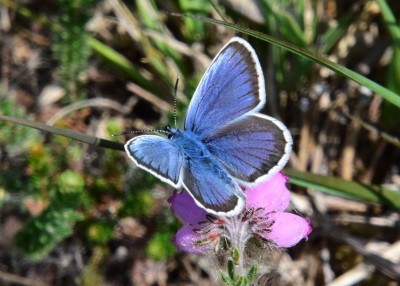
- Silver-studded Blue - Higher Hyde Heath 16.06.2021
After enjoying some good weather down in Dorset, the weather turned on us at the end of the holiday and it rained all the way home. The following week or so saw changeable conditions with some days being nice and sunny. One of these better days was 23rd June when we had a drive down to Harbury Spoilbank to see two species that had failed to show up for us in Dorset due to the late season.
These were
Dark Green Fritillary and
Marbled White, both of which we saw in fairly good numbers here and in lower numbers at Bishops Hill later the same day.
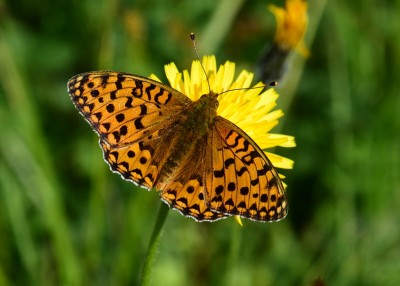
- Dark Green Fritillary - Harbury 23.06.2021
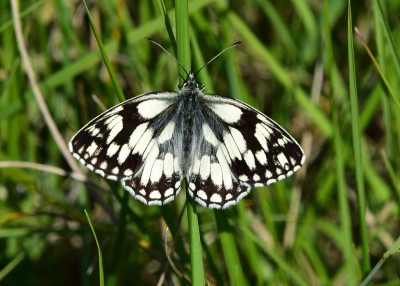
- Marbled White - Harbury 23.06.2021
Summer brood Small Tortoiseshells were also now appearing with half a dozen seen at both sites.
Bishops Hill also produced my first
Small Skipper and
Ringlets of the year.
After this, conditions crashed into a run of cool and cloudy conditions which lasted for the rest of June and into early July before more mixed but generally cool conditions settled in for the first half of that month. During the brighter and warmer spells of weather, visits to my various local spots produced increasing numbers of the usual summer species but none of them seemed to be doing particularly well apart from Small Tortoiseshells which once again were having a good year around here.
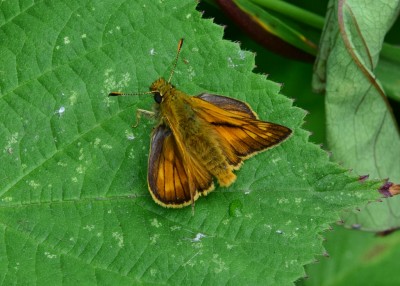
- Large Skipper - Langley Hall - 02.07.2021
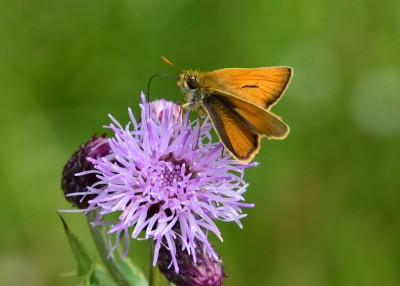
- Small Skipper - Bickenhill 12.07.2021
A visit to Oversley Wood on 5th July produced my First
Silver-washed Fritillaries which were flying in good numbers along with a few White Admirals.
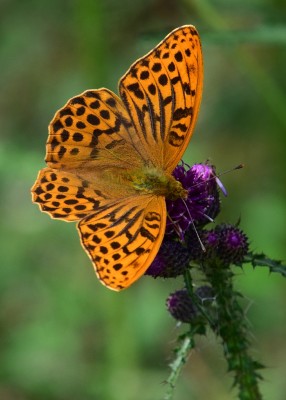
- Silver-washed Fritillary - Oversley Wood 05.07.2021
This visit also produced one of just two
Purple Emperors seen this year, the other being a surprise sighting at Snitterfield Bushes on 14th July.
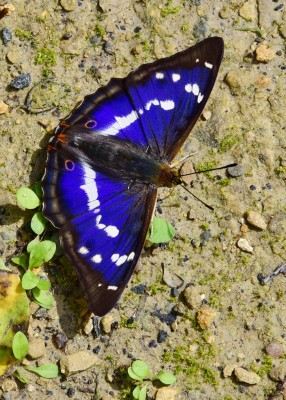
- Purple Emperor - Oversley Wood 05.07.2021
My first
Gatekeeper showed up on 12th July (at Bickenhill) but it was another week or so before numbers really started to build around here.
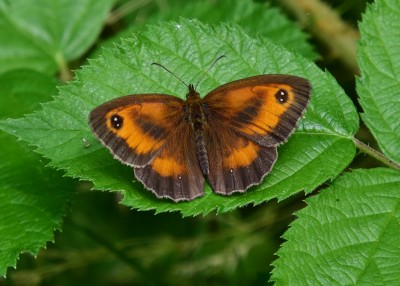
- Gatekeeper - Coverdale 23.07.2021
Later in July the weather once again switched from one extreme to the other with a run of warm sunny weather lasting for nearly week before it once again went back to dull cloudy conditions.
During this warm spell,
Essex Skippers finally showed up with good numbers appearing at my local spots although, like both Large and Small Skippers, they seemed to have a short flight period this year with some horrible stormy weather at the end of the month probably seeing most of them off.
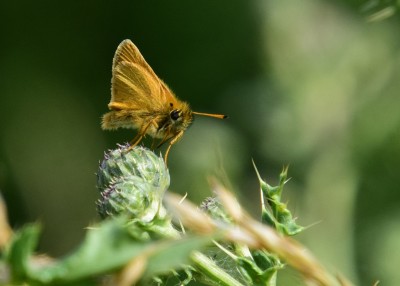
- Essex Skipper - Wagon Lane 18.07.2021
Summer Peacocks had started to appear towards the end of the month but we were into August before I started seeing good numbers, by which time most of the Small Tortoiseshells around here had disappeared into hibernation.
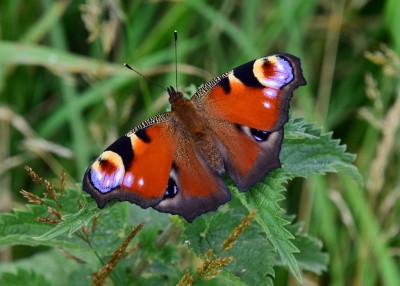
- Peacock - Wagon Lane 26.07.2021
I am going to stop there for now with the next lookback report covering late summer into autumn.
Overall, it had been a strange summer so far with some wild swings in the weather, from periods of really dull and cool conditions to brief spells of quite hot weather. With one or two notable exceptions (Small Tortoiseshell) most species were down in number around my local spots although, as I have mentioned before, there could be a degree of observer bias here as there were quite a few days when I simply did not go looking when the weather was particularly dull and miserable.
To be Continued…
Neil.

 Goldie
Goldie 